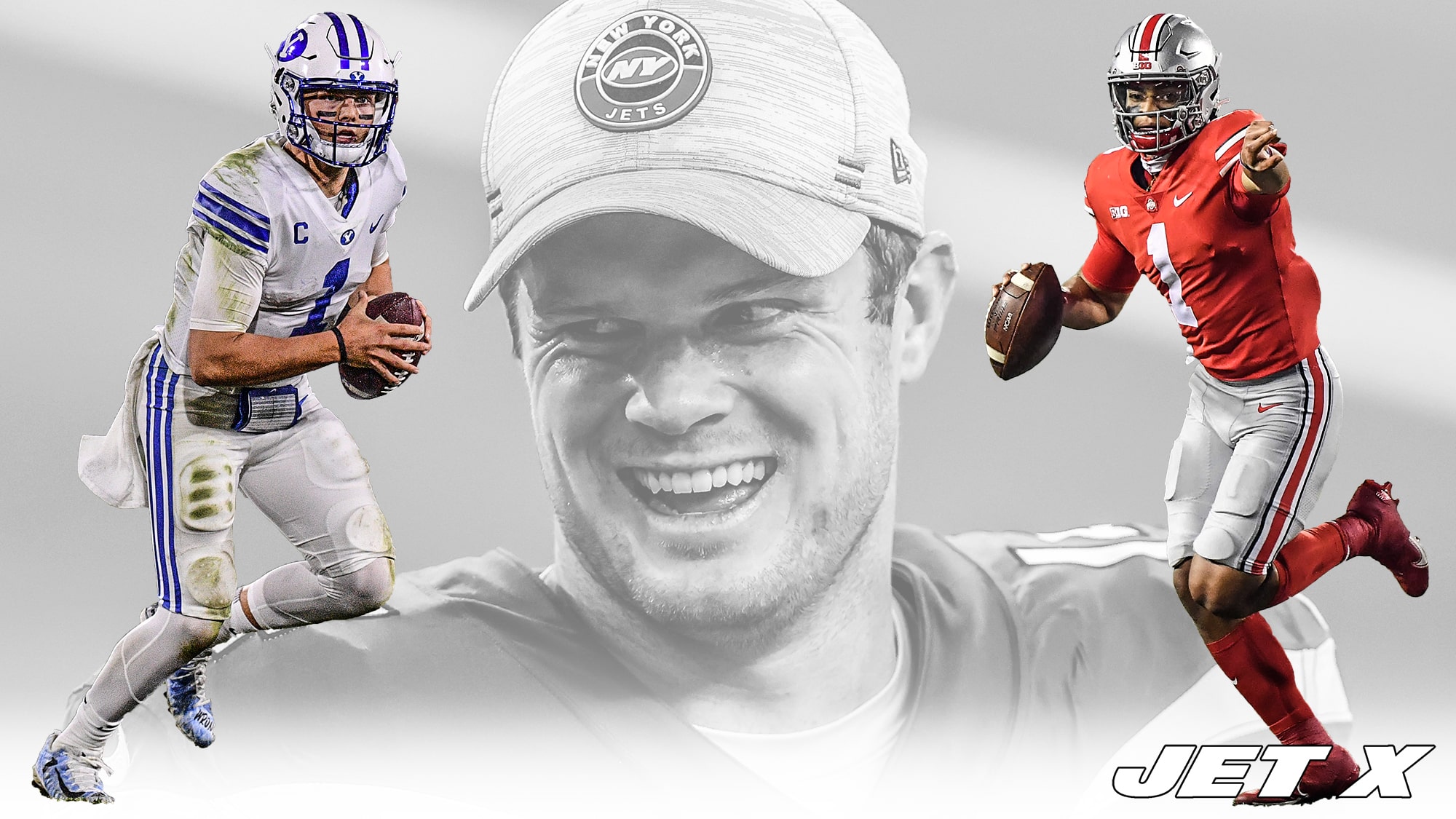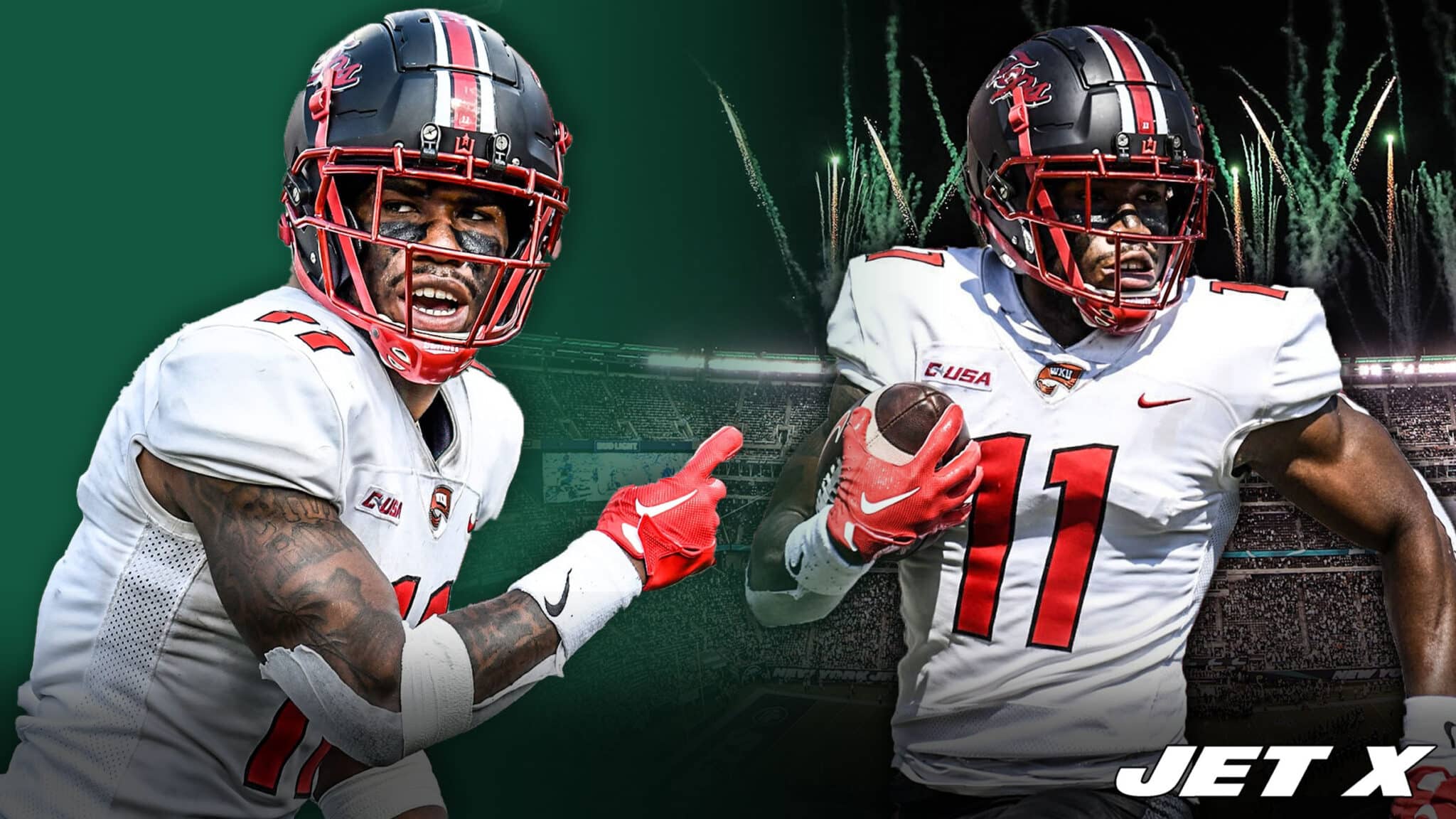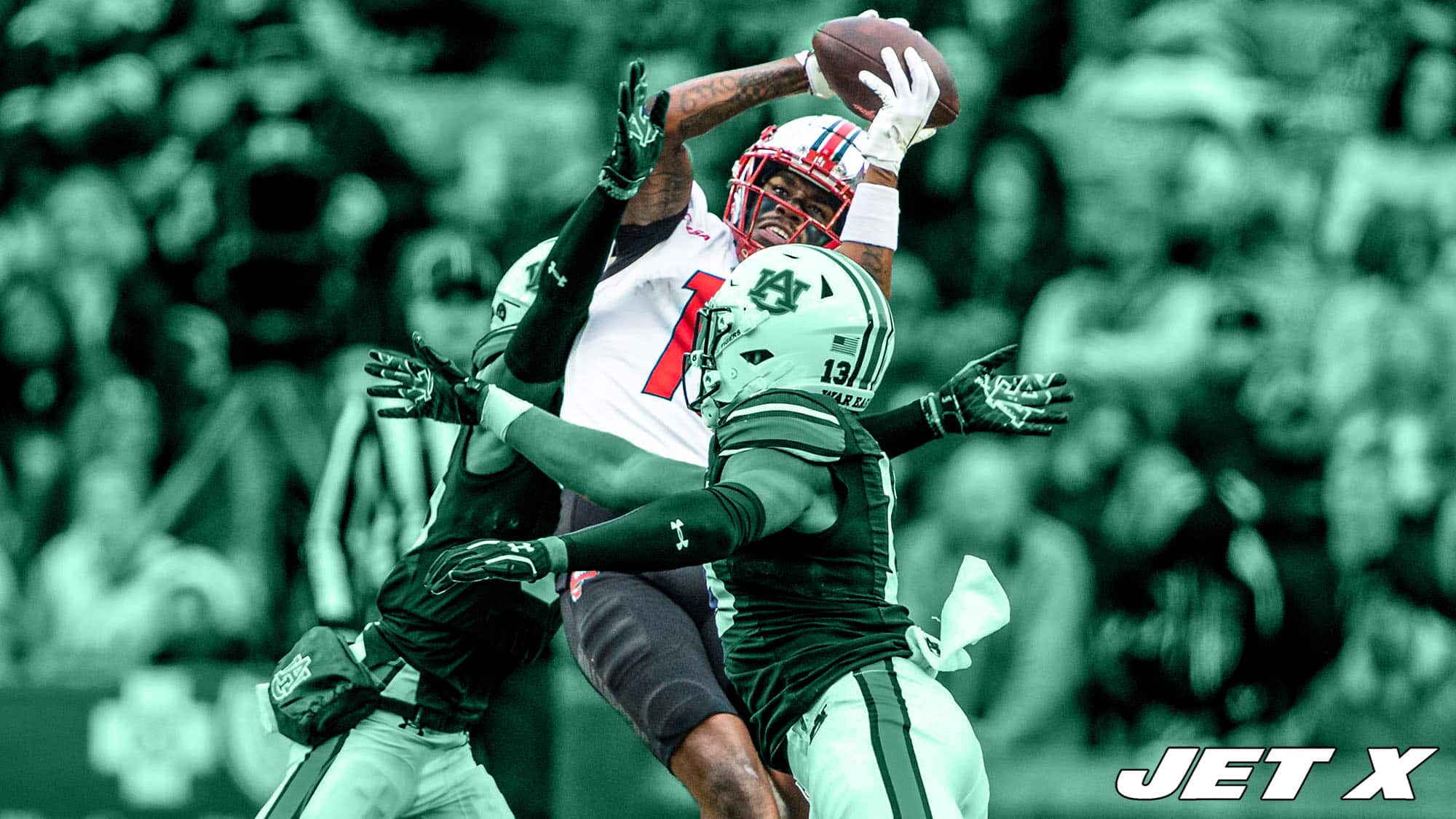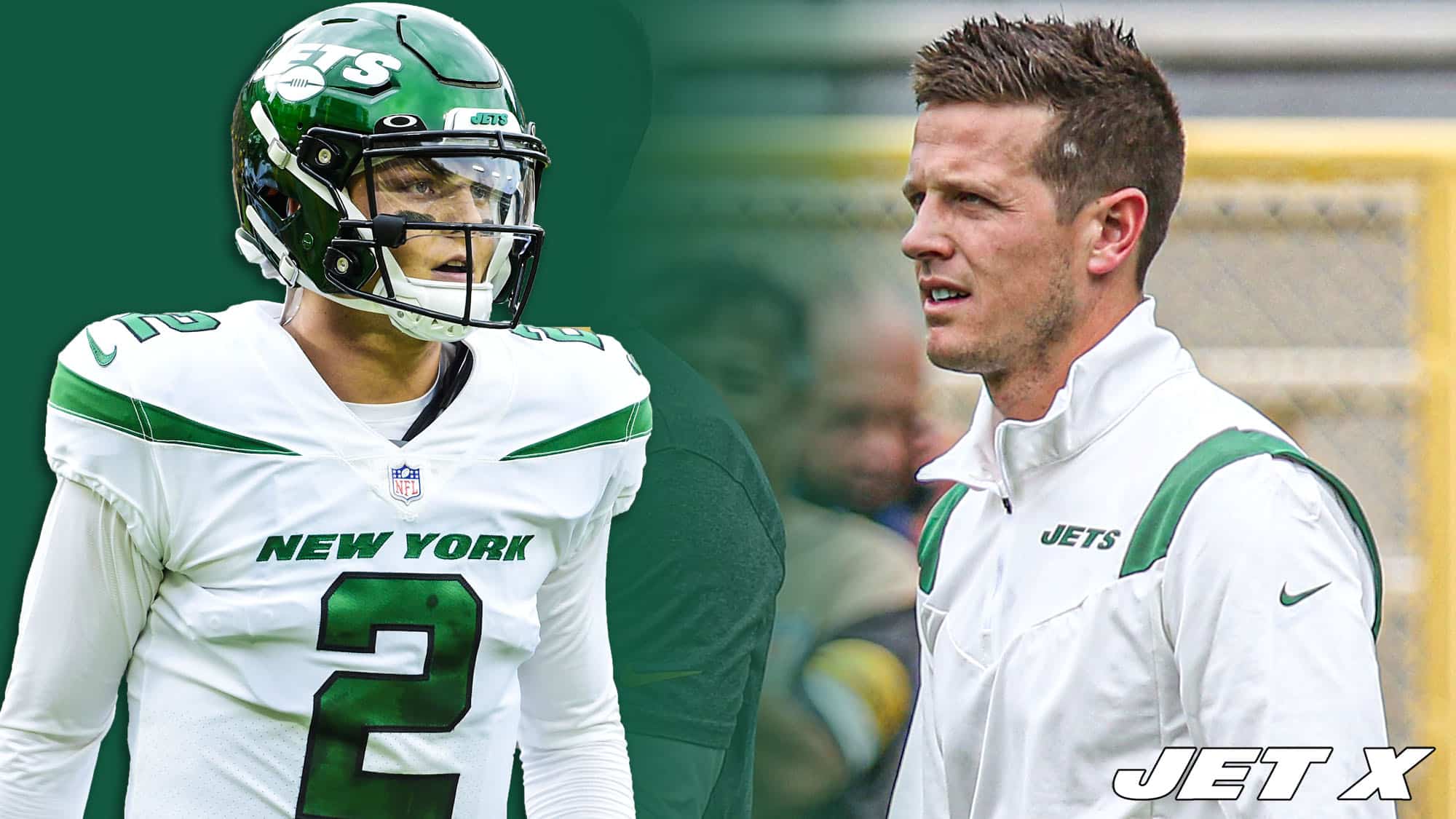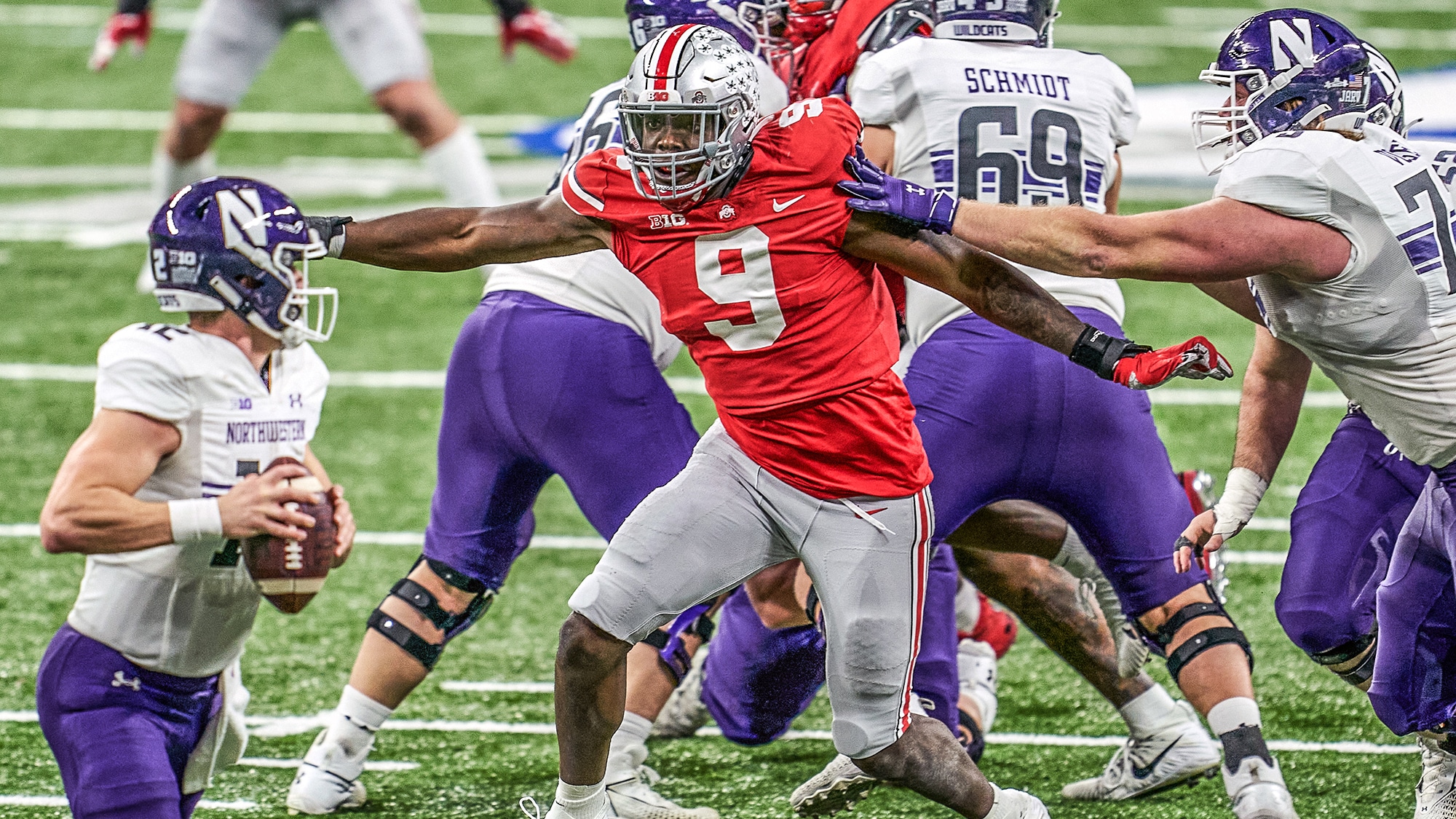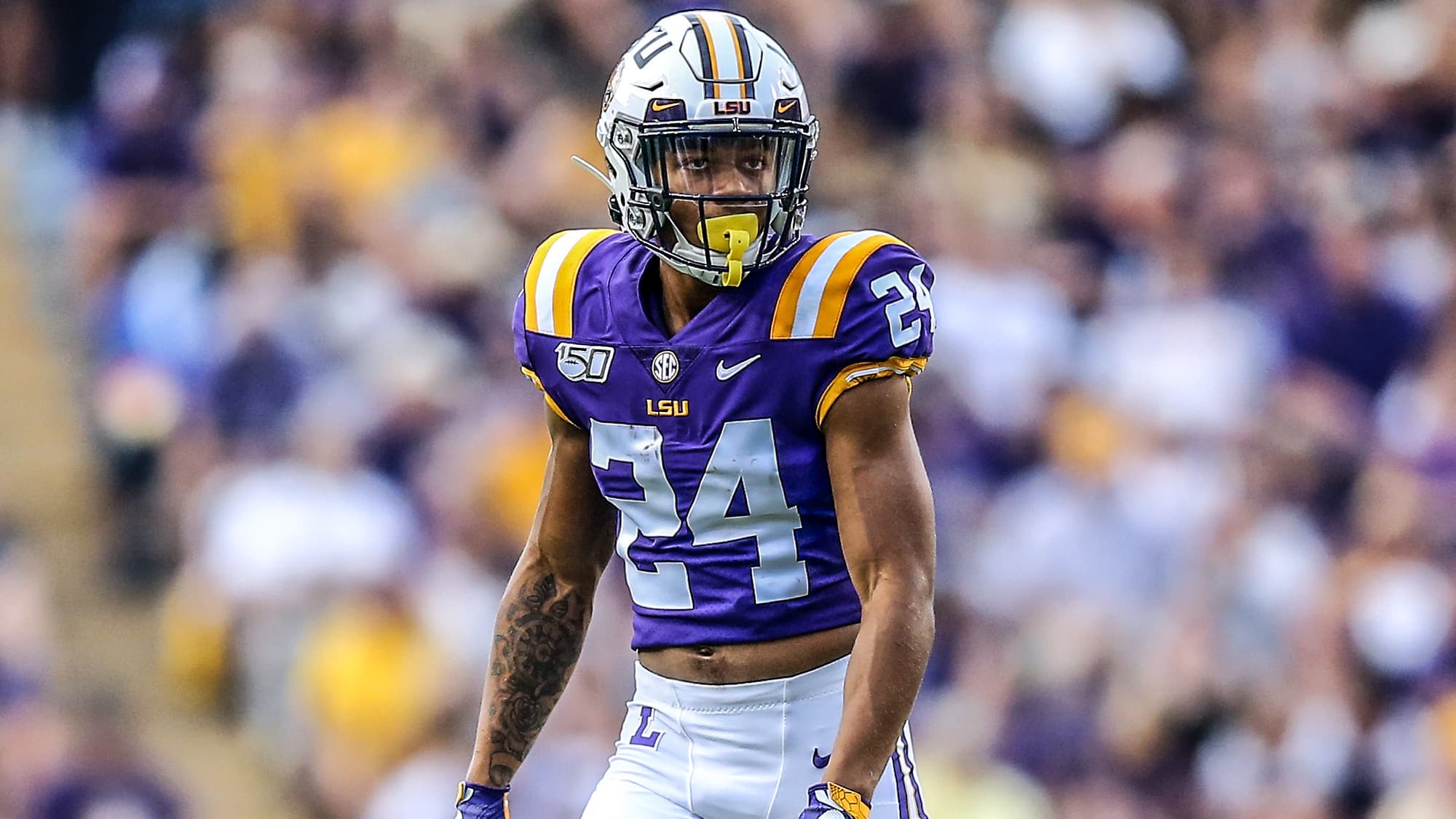Sam Crnic answers questions regarding the New York Jets’ decision between BYU’s Zach Wilson‘s and Ohio State’s Justin Fields.
With the New York Jets dropping to the No. 2 slot in the 2021 NFL draft (for now), fans have turned their attention to the two prospects leading the conversation after Trevor Lawrence, Ohio State’s Justin Fields and BYU’s Zach Wilson.
Many Jets fans caught their first glimpse of Wilson against UCF this past Tuesday. Wilson blew up Twitter with a marvelous performance—26-for-34 (76.5 completion percentage) with five total touchdowns and zero turnovers. In his best game of the season, Zach had a season-high 98.5 QBR (ESPN’s total quarterback rating).
Experiencing a Joe Burrow-esque rise up the draft boards throughout the season, Wilson has placed himself in the mix to be the second quarterback off the board. Personally, I have him as my QB2.
On the contrary, Fields had a phenomenal start to the 2020 season that had sealed his QB2 status at first among many scouts, but his recent poor performances against ranked opponents such as Northwestern and Indiana have reopened the QB2 discussion as the season nears its end. Fields will have a chance to regain faith from the draft community on Jan. 1 as he takes on Clemson in the College Football Playoff.
Today, I will answer questions regarding Fields’ and Wilson’s unique strengths and weaknesses. Should the Jets consider one of them with the second overall pick? If so, who is the better fit? Who is the better overall prospect?
While both quarterbacks offer the potential to become successful in the NFL, Joe Douglas will have to decide if either is good enough to finally give up on the Sam Darnold project.
As usual, feel free to direct future comments or concerns towards my Twitter account (@samcrnic). Let’s dive into the questions.
When analyzing Justin Fields or Zach Wilson, how do you factor in the level of competition they have each faced?
I think it’s definitely a fair point to bring up when evaluating quarterbacks. When looking at Ohio State’s and BYU’s 2020 schedules, a great difference in the competition is there.
On BYU’s side, throughout the 12-game schedule, there’s only one ranked opponent left in the latest top-25 selection (Coastal Carolina). On Ohio State’s side, you see two (Northwestern and Indiana) ranked opponents with a much shorter seven-game schedule. This doesn’t count Ohio State’s matchup against No. 2 ranked Clemson on Jan. 1, plus a potential matchup with the winner of No. 1 ranked Alabama and No. 4 ranked Notre Dame.
Most importantly, BYU doesn’t have to play the significantly harder competition that is the Big 10 conference. Instead, there were opponents such as North Alabama that didn’t even look like a Division I football team compared to BYU. It takes a lot for me to say that as well. Wilson’s pocket was in perfect condition almost the entire game, the run game was sufficient, and the coverage was terrible in zone and man.
The following play was one of the best examples of that. Wilson, with all the time in the world, launches the ball to the post-route down the middle of the field.
Despite double coverage, his WR has virtually no trouble bringing the ball down to his grasps, making for a nice highlight-worthy play. Without looking at who they’re playing, you’d think come to think this BYU team is some top-five contender for the national title. This is when the level of competition matters the most when scouting.
For every game against a bad opponent, I try to look at a much harder one in the next film session. Only then do you see the flaws start to pop up in Wilson’s game.
Up against then-ranked 21st Boise State a week before the North Alabama game, Zach’s tendency to hold the ball too long to find a downfield pass worked against him. Unlike the North Alabama clip, it didn’t end in a positive play.
The much more talented Boise State defense was able to force pressure in Wilson’s face to get the sack. Zach was punished this time for holding the ball too long as he couldn’t complete his downfield progressions in time. This and many more small issues start showing up on film once you turn on the Boise State or Coastal Carolina games.
So, to answer your question, it is a large factor when a QB has faced mostly or all easier competition compared to another QB who has faced a much harder schedule. For Wilson’s case, I wouldn’t say it’s too much of an issue due to having faced a fair-enough combination of harder and easier opponents.
What helps to scout him is the number of games BYU was able to play in 2020 in regard to the current climate of COVID-19. In this way, a scout gets to see 12 different versions of Zach despite the competition faced.
Thanks for the question, @dool_75.
In today’s NFL, do you think the athleticism factor pushes the Jets’ pick toward Fields?
I wouldn’t say it will push the Jets’ pick towards Fields, but his athleticism is enough to second-guess taking Wilson at No. 2 even if he’s the clear-cut QB2 come April.
Despite this, Fields’ impressive athleticism could instead prompt a much more run-based offense that takes advantage of his unique skill set. While the QB power is a tedious thing to run at the NFL level given the complexity and amount of ideal personnel needed, the Jets could see a lot more usage of zone reads and RPOs (run-pass-option) compared to the Darnold era.
With the amount of zone reads Fields has run at Ohio State, this simple concept should provide similarity as Fields transfers from the college to NFL level. He should also be rather exceptional at reading defenders at the mesh point as shown here.
Pre-snap, Fields has to read the weak side edge (7-tech) and which player he commits to during the handoff process. With the defensive end committing to the running back almost instantaneously off the snap, Fields makes the easy decision to keep the ball and bounce outside. In addition, the split flow H-back helps seal off the lane towards the end zone.
This isn’t the most athletic play by Fields despite the single defender he managed to evade, but it shows the level of stress put on defense when a QB as athletic and dynamic as Fields is in the red zone. Wilson can easily run this concept as well, but Fields is a much more refined runner when it comes to evading tackles and physicality.
He’s honestly a Cam Newton-esque build but slightly shorter and smaller. Just like Newton, he’s a tough guy when it comes to taking hits.
In addition to his natural athleticism, Fields’ large stature for a QB allows him to be confident in the pocket and take necessary hits to be able to step into a pass. This toughness he’s had his entire career warrants respect from all parties. There was a terrific example of this in his 2020 Rutgers film.
Looking for the deep shot off the snap, Fields’ eyes the fade route down the boundary side of the field. Sensing a collapsing pocket from the interior, Fields stays true to the read and steps into the pass despite taking a hit immediately following the release. He manages to fit the ball between the trailing defender and the single-high safety.
To answer your question, the athleticism factor definitely plays a part, but not so much as to favor one QB over the other. As of right now, I believe Joe Douglas favors Fields over Wilson—as highlighted in a previous article—but I think the combination of arm talent, play-making and scheme-fit (depending on the new head coach) will reign supreme in the scouting process when we get closer to April.
Thanks for the question, @mtpallas.
How would you evaluate Justin Fields in regard to his tight-window throws and ability to progress his reads?
I’m a big fan of Fields’ ability to fit passes through tight windows, but I’m a larger critic of his ability to progress reads as of now. His arm talent was never the question. It’s his mental processing that remains so.
Coming into college, there wasn’t much to complain about Fields’ game. Once transferring from Georgia to Ohio State, and playing out the entire 2019 season, the arm-talent was widely impressive from an accuracy and arm-strength aspect. There was also plenty to love about how Fields could easily fit throws around oncoming defenders with impressive arm angles.
When watching Fields, the initial overview is just how much velocity he can put on the ball. This velocity allows him to throw between tight windows many QBs can’t compete with. His natural throwing motion allows him to rip through the ball, combining bullet throws and pinpoint accuracy into one package.
This play is a perfect example of that marriage between velocity and accuracy that becomes a large part of Fields’ rise to success. Being able to fit the ball between the trailing cornerback and the over-the-top safety is such an impressive feat when realizing how small of a window this truly is.
Fields is doing nothing more than staying on his first read, hoping it develops into an open receiver downfield. This assumption is correct, warranting a throw from Fields to the front of the end zone. The location of the pass towards the WR’s outside shoulder gives the over-the-top safety no chance at the ball, forcing him to instead attempt to push the WR out of bounds before he can land his feet.
The amount of arm strength required to make this throw is beyond what most QBs can offer, even at the NFL level. Although Fields holds on too long to his first read to my liking, he makes up for this with the tight-rope pass.
It’s worth noting Fields’ impressive tight-window ability can be done from the pocket as well as on-the-run. Off the play-action, Fields is forced to scramble to his right, throwing off his back-foot to a spot only where his WR can snatch the ball.
Even with a defender right in front of him, Fields stays relentless in his efforts to deliver the pass and does so in an accurate matter. All the WR has to do is quickly flip his hips and make the adjustment to the ball to lay in the catch along the field side sideline.
Recently, there’s been a lot of talk about Fields’ reliance on his first read, which has caused much disbelief in his potential at the next level. While this criticism is warranted due to Justin’s recent poor play as-of-late, there’s proof that Fields can easily survey the field as well as any QB with enough time in the pocket.
Regardless, Fields doesn’t even need to survey the field most of the time because of how open his first reads often are. When his first read wasn’t open, such as this play, Ohio State does a nice job of preparing half-field reads for Fields to quickly progress to the next guy.
This clip combines the impressive tight window throwing ability and the potential to progress upon his reads all in the same play. Notice the route combination, where most of the WRs are “flooding” to one side of the field (boundary side). This is what gives Fields his half-field reads, shrinking the area of where his eyes need to progress to.
While this wasn’t the case for all of his successful second or third read throws, Ohio State has built a successful yet efficient offense tailored to Fields’ strengths and weaknesses as a QB.
To answer your question, Fields’ tight-window precision and overall accuracy are some of the best you’ll see in a prospect, with a few occasional inaccuracies seen throughout the progression of a game. As for his second or third read throws, it’s more of a work-in-progress for Justin. There’s been a clear sign of improvement from 2019 to 2020, but there have still been enough missed opportunities against ranked opponents this year to warrant skepticism heading into the 2021 NFL draft.
Thanks for the question, @bols56_mike.
Is Zach Wilson’s decision-making and accuracy as impressive as people think or is it just because he has a play-style similar to Patrick Mahomes?
After watching a good nine or so games of his film thus far, I’d say he’s very much-so deserving of the Patrick Mahomes hype. I wouldn’t make a direct comparison to Mahomes, but they have similar play-styles that can generate excitement.
Wilson came to a struggling 4-9 BYU football team as a freshman, looking to turn the program around. Three years later, he achieved his goal, attaining an 11-1 record with a sole loss to a top 10 team in the country. What could be seen in Wilson’s game over the course of those three years were massive jumps after each consecutive season.
For someone who possesses such impressive arm talent, there was not always optimism surrounding his future. Wilson had surgery on his throwing shoulder (right) due to a torn labrum suffered from his senior year of High School. The pain from High School dragged into his freshmen year at BYU, affecting his range of motion during the week.
“It always felt great in games … The problem was coming into practice the next Monday. I just felt terrible. So I would go into Mondays and I could barely lift my arm up because I was getting driven down on my right shoulder, and guys were landing on me.”
After a successful surgery and work on his throwing mechanics, Wilson was back to normal. It’s worth bringing this up because of how much pressure he puts upon his shoulder on a week-to-week basis. Without looking up their heights, a fan would never know that Fields and Wilson are listed at the same height (6-foot-3). For an individual of such a smaller frame compared to other QBs in the NFL, the shoulder injury history will be kept in the back of scouts’ minds.
Regardless, there are some serious Mahomes or Aaron Rodgers-esque throws in almost every game of 2020. These are the on-the-run, cross-body passes that show up all over social media on a weekly basis. Perhaps one of the best throws came against Boise State where Wilson runs to his right only to launch a pass 45 yards down the field to his target.
Obviously, there are still negatives about the play. He bails the pocket too quickly, he takes too much of a risk with the long pass, and the throw seems to hang too long in the air to be completed in an NFL game. But this is the modern NFL. Cross-body throws and effortless 50-yard tosses have defined the league for the past three years and there’s no stop to that in sight.
If that still doesn’t convince you that Wilson is ready for stardom in the NFL, Zach has every other trait you wish to see in a QB prospect as well.
The combination of quick mental processing, athletic build, ability to scramble out of pressure and exceptional accuracy make this guy even more special than many people realize. For someone who loves to make plays out of the pocket, he can impress within the pocket as well.
This play was a great example of that. The quick decision-making to go from one side of the field to the other in his progressions is rare for a QB coming out of college to already have.
While the WR does most of the work with his impressive double-move route-running, most QBs have trouble surveying the field this efficiently. Some QBs, including Fields, may miss the read entirely and just settle for an underneath route or choose to scramble away. That is the difference between protecting a QB (half-field reads) and unleashing him.
To answer your question, the decision-making and accuracy featured in Wilson’s game are some of the impressive I’ve seen on All-22 film. The guy takes more risks and downfield shots than most QBs yet still has only thrown three interceptions in 12 games. But the most exciting part of his game is the potential that still exists once entering the NFL. Even Hall of Fame QB Steve Young made his pitch on the talented BYU QB:
“The more they ask of him, the better he gets. A good buddy of mine was coaching the kid in high school, and he was telling me there’s something special about this kid. He can do things that no one else can do.”
The comparisons range from a more-athletic Baker Mayfield to Aaron Rodgers, yet Fields still doesn’t describe the entire nature of Wilson’s play. The ability to scramble out of the pocket and deliver Mahomes-type throws, while still having the necessary pocket presence to be able to maneuver through pressure, make Zach one of the more exciting success stories leading up to the 2021 NFL draft.
Thanks for the question, @KFernelis.
Who would be the right hire at head coach for both Zach Wilson and Justin Fields based on schematic fit?
This is definitely one of the more popular questions surrounding the acquisition of either Fields or Wilson. While there are a lot of answers for either QB, it all depends on whether the eventual coach will adjust their offense to fit in Fields’/Wilson’s specific strengths and weaknesses.
In addition, numerous head coaches would be in play for the Jets if acquiring Fields/Wilson as long as they hire the right offensive staff to build around the new QB. For example, current San Francisco 49ers defensive coordinator Robert Saleh would present an excellent head coach option for Wilson if bringing along run game coordinator Mike McDaniel as his offensive coordinator.
McDaniel is the mastermind behind the 49ers’ lethal running game in 2019 and 2020, helping the likes of running back Raheem Mostert and tight end George Kittle earn extensions with the team. The 37-year-old Yale graduate has been with 49ers head coach Kyle Shanahan in Houston, Washington, Cleveland and Atlanta, before joining San Francisco in 2017. Kittle jokingly expressed his pleasure with working with McDaniel when signing his extension:
“I want to put him in my contract. You can’t poach him. I want to be with him for the rest of my career.”
While most like to crown Shanahan for his handling of the 49ers’ impressive offensive scheme, McDaniel is the true star behind the scenes. Most of the new run designs and wrinkles used in the 49ers in 2019 and 2020 have come from McDaniel as opposed to Shanahan. Former Cleveland Browns wide receiver Andrew Hawkins (who worked with McDaniel in 2014) stated that he would “bet every dollar in my account that no other candidate understands offensive football the way he (McDaniel) does.”
Given how integral the running game is at BYU to Wilson’s success, a defensive head coach could bring the best possible offensive scheme to play to Wilson’s strengths and weaknesses as a QB. On the first play of the game, watch how the second and third-level defenders are pulled by the play-action, only to set up a one-on-one matchup along the perimeter.
From there, Wilson showcases his amazing deep ball accuracy by putting the ball in a place only his WR can grab it. These deep shots off the threat of the run would instantly put Wilson in a perfect situation to thrive as an NFL QB. It simplifies the game for rookie QBs and also provides similarity to what was already run in college ball.
The best head coach to pair Fields with would be Buffalo Bills offensive coordinator Brian Daboll. Daboll has been the talk of the league in 2020 for transforming QB Josh Allen into an MVP-caliber player, by transforming the offense around his strengths and weaknesses. A player of similar impressive athletic traits, Fields needs to land on a team that tailors the offense to his exceptional running ability and arm strength. In other words, his future coach needs to unleash his potential, and not just protect his weaknesses.
There is more potential in Fields’ game than people give him credit for. Sure, he had bad games vs. each ranked opponent he faced in 2020, but this doesn’t define him as a player.
What people don’t see is the mental processing strides he’s made in previous games. I don’t recall a better statistical start to the season than what Fields did in his first three games as a junior. Throwing for 908-yards and completing 72 of 83 throws, Fields completed the same amount of throws as touchdown passes (11).
The following is one of my favorite plays during that three-game span that displayed his potential his working through his progressions.
Although he was in a rather cleanly-protected pocket the entire duration of the play, this was still a good notion of what’s yet to be consistently unleashed in Fields’ game. He even showcases the toughness I love to rave about, taking a hit as he steps into the accurate pass.
The narrative that Wilson is the clear-cut QB2 with four months left to go until the draft is not true. Fields, just like Wilson, is part of an extremely talented QB draft class who all have the shot to be the best QB taken out of the bunch.
As for both QBs, a great option for a head coach based on schematic fit would be Tennessee Titans offensive coordinator Arthur Smith. Like McDaniel, Smith’s offensive success is heavily determined upon the reliance on the run game, which sets up opportunities downfield and across the middle.
Both Fields and Wilson would quickly thrive in an offense with these principles, as it completely fits their style of play. As an example of this, Fields (as shown below) has the arm talent to loft a ball up and over second-level defenders as he attacks a crosser route, something Arthur would love in his offensive attack.
Off play-action, Fields has a split flow blocker to help on the right side of the offensive line, while ideal protection on the left side gives the WR enough time to pass the middle of the field. From there, Fields lofts his pass up and over the linebackers while hitting his WR in stride as he gains depth along the sideline.
This is a play we’ve seen Ryan Tannehill and the Titans run almost every game of the season. Not only does the play-action create time for the QB, but it’s also a relatively easy scheme for a young QB to thrive in. (I covered this in my scheme overview of the Titans’ 2020 All-22 film.)
Drafting either Fields or Wilson with the second overall pick becomes very likely when considering the risks of keeping Darnold for year four. No matter who they end up picking, the Douglas and the Jets will align a specific offense towards that QB’s strengths and weaknesses. If they fail to tailor to the QB’s ability early on, the Jets may see themselves making the same mistake they have with Darnold.
Thanks for the question, @BustinFields.

